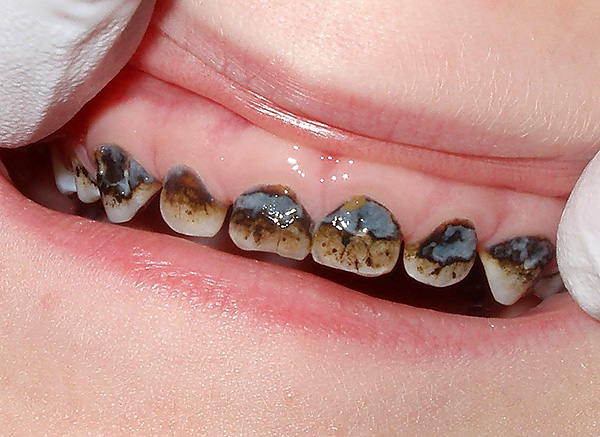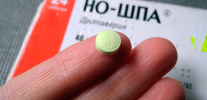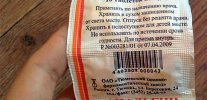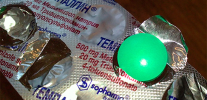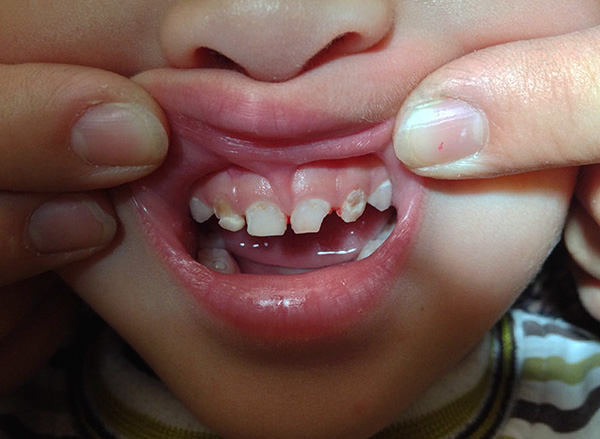
The child’s teeth can hurt at any age, even at 1.5-2 years, when, it would seem, they only barely managed to erupt. The most common cause of toothache is tooth decay, which often develops unnoticed by the baby's parents until one day the child begins to complain of sharp or aching pain.
Often this problem takes parents by surprise: sometimes at night, sometimes at the weekend, when there is no way to immediately go to the dentist. In this case, it is important to provide the child with first aid correctly, since it is quite possible to anesthetize a tooth at home - it is only important to approach this correctly so as not to aggravate the situation.
Depending on the age of the child and the cause of the toothache, the methods of pain relief can vary significantly. Most medications that help adults well can not be given to children under 12 years old. To relieve toothache in babies, special children's medications are used - a little later we will consider them in more detail.
On a note
Do not underestimate the usual mouthwash - warm clean water. With deep caries, pain often occurs due to the irritating effects of food debris that enter the carious cavity. It is enough to rinse your mouth thoroughly to significantly relieve toothache or even eliminate it completely (if it has not yet reached pulpitis).
Why can a child have a toothache
It is useful to keep in mind that although caries is the most common cause of toothache, other pathologies can also cause pain in the child’s oral cavity:
- Chipping and destruction of tooth enamel (if the baby has recently fallen and one or even several teeth could be damaged);
- Pulpitis and periodontitis (usually accompanied by acute spontaneous pain, which can not be removed by rinsing the mouth);
- Flux (purulent inflammatory process in the area of the periosteum of the tooth - visually looks like a lump on the gum);
- Abscess (the whole cheek can swell greatly);
- Complications after tooth filling (if you recently visited the dentist who prepared the tooth) ...
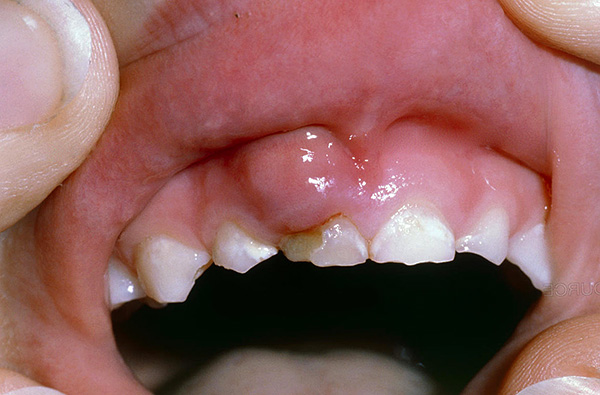
As well as teething, gingivitis, stomatitis and other factors.
As for caries, it causes aching or sharp paroxysmal pain. First, it appears as a reaction to a cold, hot or sweet, and after a couple of minutes it subsides (for example, a child’s tooth may hurt right after eating, and then the pain goes away on its own).
With a deep damage to the tooth, the pain can appear regardless of the action of stimuli and not last long.
Carious tooth damage can be recognized by the characteristic dark (yellow, brown, black) spots on the teeth. Even if the dark dot looks small, under it there may well be an extensive carious cavity that reaches the pulp chamber of the tooth (the tooth “nerve” is in this chamber), which causes severe pain.
The photo below shows an example of deep caries in a child:
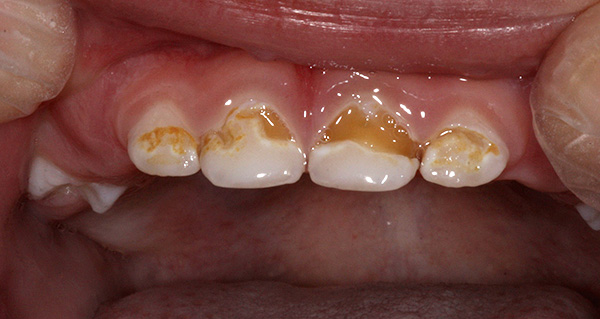
Caries can develop on baby teeth, even in infants. The so-called "bottle" caries occurs in children aged 0 to 4 years due to insufficient oral hygiene. It begins with white spots at the base of the tooth (at the gums) and quickly spreads over all teeth.
The photo below shows how “bottle” caries can look at the initial stage:
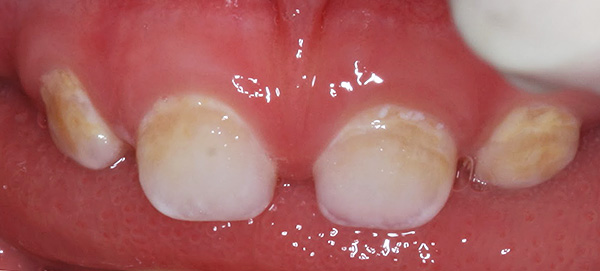
And so the baby’s teeth can look if the situation is started:
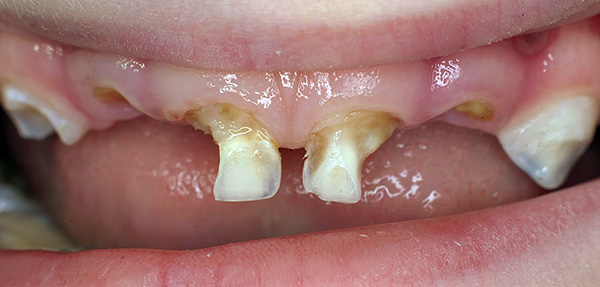
On a note
On milk teeth, caries usually develops much faster than on molars (permanent). Literally in 2-3 months superficial caries can turn into deep.
Deep caries, if it cannot be cured on time, can lead to the development of pulpitis - inflammation of the soft tissues of the tooth. If the infection is not eliminated at this stage, then it can go to the root of the tooth with the development of periodontitis. Both of these diseases are accompanied by very strong acute, throbbing pain, which can spread to the entire jaw, larynx and ear. Also, a reaction to temperature stimuli and exacerbation in the evening and night is characteristic.
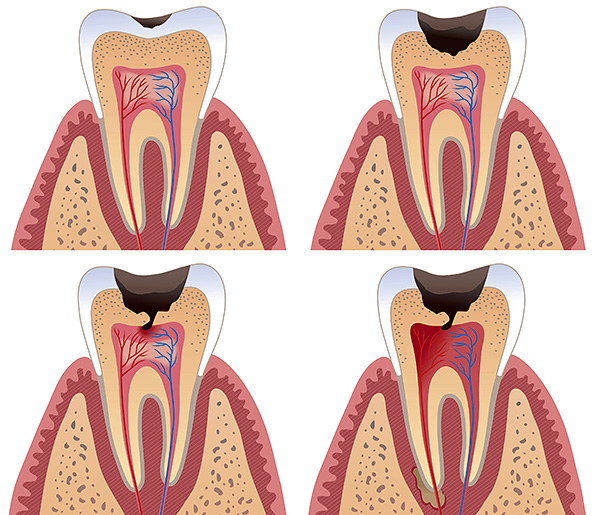
Sometimes tooth pain appears after treatment by a dentist. There may be several reasons for this, and the most common of them:
- Damage to the tooth pulp (for example, overheating during preparation, although this is very rare today);
- Allergy to filling material.
In some cases, the pain can go away on its own in a few days or a week, in others it may require re-opening the tooth and replacing the fillings. Therefore, if positive dynamics are not observed, it is important to re-show the child to the doctor. An x-ray may be required to clarify the diagnosis.
Purulent diseases - flux, abscess can also provoke severe toothache. They are easily recognizable by the swelling of the gums and the formation of bumps near the diseased tooth. In severe cases, the baby's face can become asymmetric, the body temperature rises - in such a dangerous situation, it is important to immediately consult a doctor.
On a note
If the child has a swollen cheek, but not a single tooth is ill, this may be a symptom of gingivitis, lymphadenitis, inflammation of the facial nerve or salivary glands, an allergic reaction, and some other diseases. And here it is also important to contact a pediatrician as soon as possible.
About the danger of such conditions
Contrary to popular belief, decay on deciduous teeth needs to be treated, even if they should fall out soon. Firstly, the carious process can deepen and reach the "nerve" - this will lead to severe pain. Secondly, an infection (with periodontitis, for example) can spread to the rudiments of molars that have not yet erupted and permanently damage them.
In addition, premature loss of milk teeth leads to gaps in the dentition and can provoke the formation of an incorrect bite. Do not forget about the accompanying psychological problems, often accompanying children with bad teeth (the baby is shy of his “rotten” teeth, afraid to smile for years, he is constantly teased by peers).
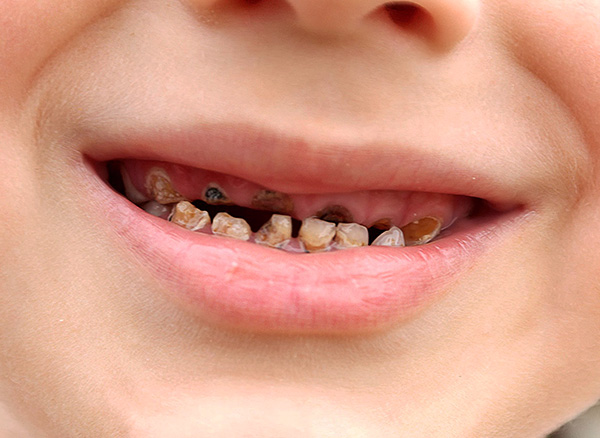
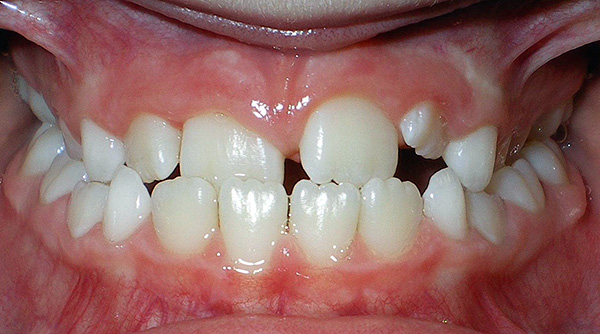
The easiest way to cure tooth decay at the initial stage of its development. With deep caries and, especially, pulpitis and periodontitis, a more complex treatment is required.
With purulent pathologies (flux, abscess, phlegmon) without treatment, the disease can spread to neighboring healthy teeth, leading to their mobility. In difficult cases, this can lead to tooth loss.
On a note
If a toothache tormented the child for several days, and then abruptly stopped, this does not mean that the disease has passed. As a rule, relief is due to the fact that the tooth pulp (“nerve”) dies - therefore, sensitivity disappears. It is important to understand that the infection has not disappeared - the necrotic neurovascular bundle inside the pulp chamber begins to decompose with the formation of pus, which will form the focus of inflammation on the root of the tooth.
No less dangerous is a disease such as gingivitis (gum disease). When its symptoms appear, many consider the problem insignificant and refuse to visit a doctor, preferring to treat the child at home. With improper treatment of gingivitis, it can become chronic, causing abscesses in the gums and jaw bones. Meanwhile, with proper treatment, the disease goes away in 1-2 weeks.
The following are situations where the baby must be shown to the doctor:
- Explicit tooth decay with caries;
- Acute pain in a tooth or gum;
- Aching pain in the tooth that does not go away for a long time;
- Swelling of the gums or the appearance of bumps on it;
- The appearance of ulcers in the oral cavity;
- Swelling of the cheek (even without pain).
Do not delay the visit to the doctor, believing that you only need to wait a bit - and the milk teeth will fall out themselves. In children, tooth enamel is thinner than in adults, and, in addition, is less mineralized, so tooth decay often develops rapidly, quickly leading to complications. Therefore, even when white spots or small brown dots appear on the baby’s teeth, it is absolutely necessary to see a dentist.
The photo below shows caries of primary teeth at the initial stage:
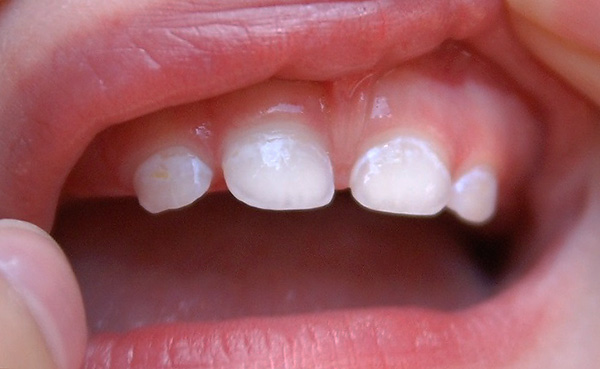
Practice shows that sometimes parents give an anesthetic drug to a child with the expectation that the medicine will relieve pain and eliminate the need to visit a dentist (because it is very stressful for the child). After taking the medicine, the baby can really get better, however, painkillers do not cure the disease, but only temporarily reduce the severity of symptoms.
Therefore, if the baby’s teeth react to hot and cold, or he often complains of pain in one tooth, then the trip to the dentist is better not to postpone. In the initial stages of caries, it is much easier to treat than with the appearance of its complications.
First aid for a child with toothache
At home, caries or pulpitis cannot be cured, but it is quite possible to reduce the accompanying pain syndrome. The choice of funds depends largely on the age of the child - some drugs are suitable for children from 3 months, while others are contraindicated up to 12 years.
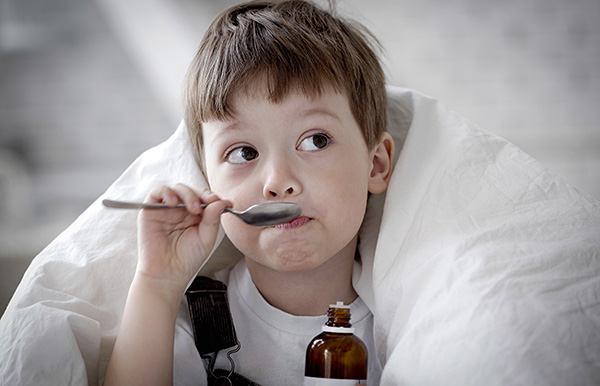
It is worth noting again that often toothache can be removed by rinsing the mouth with warm, clean water. When the child gets older and can rinse his mouth on his own, you can use special solutions.
When choosing an anesthetic, you need to carefully study the instructions for its use, pay attention to contraindications and side effects. If it is not possible to immediately take the child to an appointment, then, if possible, it is better to consult a doctor at least by phone.
So, consider the drugs that are commonly used to relieve toothache in children ...
How to help a child from 3 months to 12 years
For toothache and gum disease in children aged 3 months to 12 years, the following are usually used as an emergency measure:
- Paracetamol-based preparations: Panadol, Efferalgan, Cefecon and some others;
- Preparations based on ibuprofen: Nurofen (in syrup and suppositories), Ibuprofen.
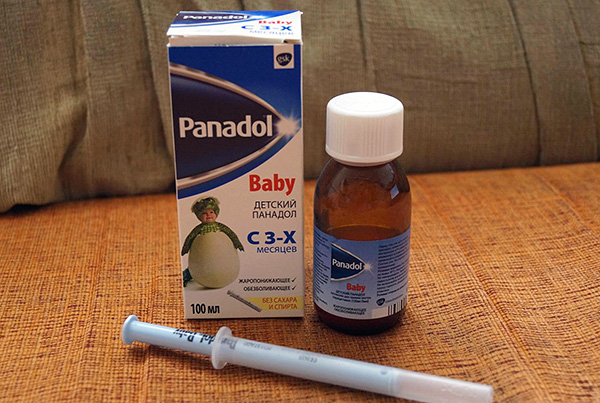
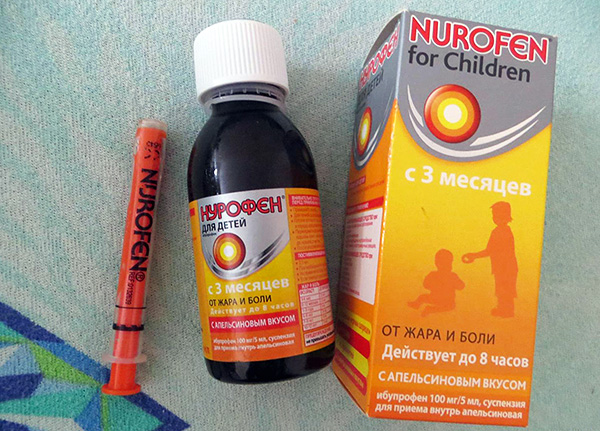
Paracetamol provides analgesic, anti-inflammatory and antipyretic effects. It begins to act in about 20 minutes, and the effect lasts up to 6 hours.
Ibuprofen-based medications are also popular. For example, children from 3 months in the absence of contraindications are allowed to use Nurofen in syrup or suppositories (Nurofen in tablets is used in children over 12 years old).
It is very important to observe the dosages recommended in the instructions and not to exceed them, even if the toothache does not go away. Also, it is impossible to use different drugs in parallel on the basis of one active substance, as this can provoke an overdose.
On a note
In children, only 20 primary teeth grow. The former appear after 6 months, and the latter by 3-4 years. They begin to stagger and fall out at 5-6 years old. This age accounts for the largest number of cases of toothache, tooth decay and trips to dentists.
Painful teething in a baby can also bring a lot of trouble. In this case, the following are commonly used:
- Dental ointments and gels based on lidocaine: Kamistad, Kalgel and others;
- Homeopathic gels: Holisal, Traumeel-S, etc .;
- Dental drops for children: Dantinorm Baby, Fenistil, etc.
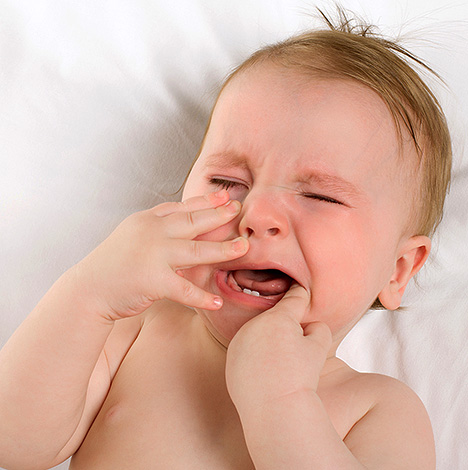
Some gels and ointments are suitable for children from 3 months, they are used to relieve aching pain when teething. In case of caries or pulpitis, they are ineffective, although if they contain lidocaine, they help to slightly reduce acute pain. - the effect, as a rule, persists for half an hour. Such gels are sometimes used to quickly help a baby before visiting a dentist.
With painful teething, Kamistad gel is suitable for infants. Its main components are lidocaine and chamomile infusion. It is used for diseases of the oral cavity and teething. Apply the gel to the gums 3 times a day.
In inflammatory diseases of the gums in children older than 3 years, the dental gel Cholisal is popular, the active substance of which is choline salicylate. Due to its thick consistency, it lasts longer on the gums, dips deep into the tissue and provides an analgesic effect for about 2 hours. It can be used up to 3 times a day. With toothache on the background of caries or pulpitis, Holisal is absolutely ineffective.
Dantinorm Baby Tooth Drops are a homeopathic remedy. They are used for painful teething in babies, but they do not relieve pain during caries or pulpitis.
When choosing the optimal drug, it is recommended to consult a doctor.
Toothache relief in children over 12 years old
After 12 years, children can take many drugs for adults, only at a lower dosage. For example, with toothache, they are usually used: Nurofen (in tablets or capsules), Nise (tablets), Tempalgin, Ketanov, Ketorol, the same Paracetamol (tablets). Ibuprofen et al.
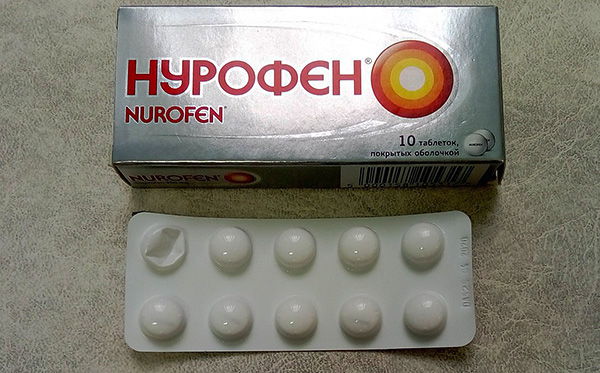
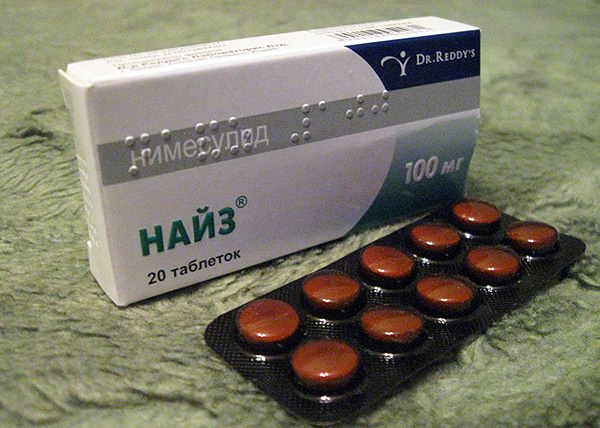
Sometimes, with mild aching pain, Analgin is still used, although in many countries of the world this drug is prohibited for use due to the possibility of serious side effects. Be that as it may, it is not worthwhile to apply the Analgin tablet to a diseased tooth, as is advised in traditional medicine, since the drug can destroy enamel (the same applies to Aspirin).
Aspirin and Baralgin help with mild or moderate aching toothache.
Paracetamol is often used in children, it has fewer contraindications, and also has anti-inflammatory and antipyretic effects. However, it is worth noting that as an anesthetic, paracetamol is not very effective and, for example, with acute toothache amid pulpitis, the effect may be clearly inadequate.
Ibuprofen-based drugs are very popular today: Nurofen, Ibuprofen, Solpafleks and others. They have a quick and powerful effect, but have a fairly wide list of contraindications and side effects. In children, these drugs and other drugs based on non-steroidal anti-inflammatory drugs (NSAIDs) should be used with great care.
Drugs based on nimesulide also help to quickly and effectively relieve toothache: Nise, Nimesil, Nimid and others. They are produced in the form of tablets and sachets, which are dissolved in water. These drugs provide a significant reduction in even severe pain within about half an hour. Allowed for children from 12 years.
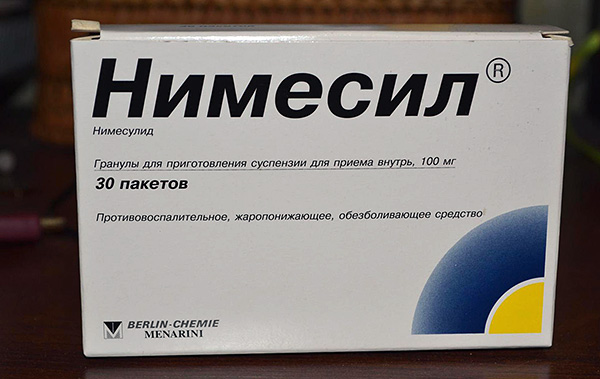
The drug Ketanov (or its analog Ketorol) also helps to get rid of intense pain, but it is contraindicated in children under 15 years of age. Ketanov begins to act within 1 hour, and the effect lasts up to 6 hours, and in terms of force of action, it exceeds all of the above tools. In addition to the analgesic effect, it also has an anti-inflammatory effect. The recommended dose for adults is 1 tablet per day, in case of severe pain, the dose can be repeated once 6 hours after the first.
On a note
It should be borne in mind that due to the individual characteristics of the body and the specifics of the pathology, sometimes, it would seem, a strong drug can poorly relieve pain, and a weaker one, on the contrary, is more effective.This happens quite rarely, but if the drug obviously does not work, then you should not increase its dosage and try to use it again and again - it is better to try another remedy.
Sometimes gels and ointments with lidocaine help relieve toothache - they have a very fast analgesic effect, but it does not last long (usually no more than 30 minutes). Lidocaine is also released in the form of a spray, which is sprayed around a diseased tooth or applied to a piece of cotton wool and applied to the gum or tooth (depending on what hurts). It is important to keep in mind that the child may be allergic to lidocaine, so use such funds, especially for the first time, as carefully as possible.
What is useful to consider when using folk remedies
There are many traditional medicine recipes that are used to reduce toothache. Some remedies are really effective, while others are hardly worth the wait.
With toothache and an inflammatory process in the oral cavity, it is really possible to alleviate the condition by rinsing with decoctions of medicinal herbs. In the absence of allergies, they can be used in children from an early age. The main thing is for the baby to be able to rinse his mouth and not swallow the solution. The smallest children can be given warm water in their mouths. As noted above, this often helps to soothe the pain.
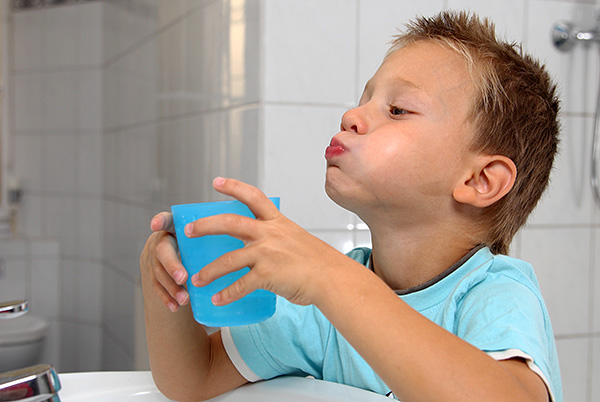
The classic solution for rinsing the mouth is prepared from water and salt (less often - baking soda). A teaspoon of salt should be stirred in a glass of warm boiled water. With this tool (namely, warm), rinse the oral cavity about once every half hour. Salt has an antimicrobial effect, helps reduce inflammation and prevent the spread of bacteria.
In traditional medicine, sage, chamomile, oak or aspen bark are also used. Doctors allow herbal remedies in young children if there is no allergy. Before preparing this or that decoction, you need to familiarize yourself with the instructions for using herbal collection. It is also worth considering that these drugs do not relieve acute toothache, they are often used in complex therapy for the treatment of inflammatory processes in addition to other drugs.
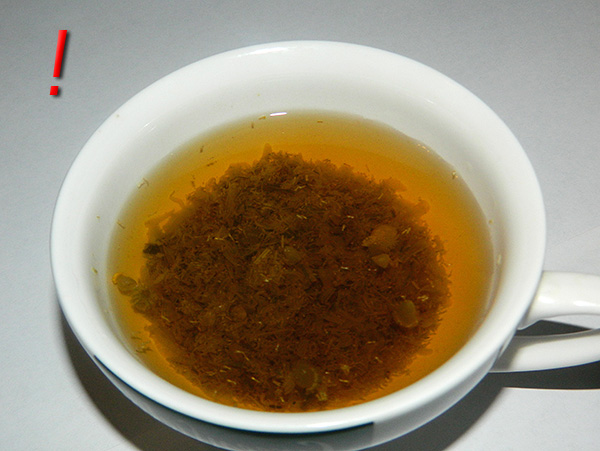
On a note
It may seem surprising, but for some reason some dubious folk methods of relieving toothache are still enjoying some popularity. So, for example, it is recommended to insert the root of the plantain into the ear, lay a piece of propolis in the carious cavity, attach a clove of garlic to the wrist, etc. Needless to say, in practice, such methods do not work. And also do not expect to cure a child’s tooth with conspiracies - a much more correct and effective option would be to visit a dentist.
What can not be done with toothache
Despite the fact that in most cases the teeth hurt in children due to caries, many other diseases can also cause pain. Accurately determining the cause at home can be quite problematic, which is why a physician should do this. And the task of the parents is to help the child at home before visiting the dental clinic, without making gross mistakes, which not only can aggravate the pain, but can also provoke the further development of the disease.
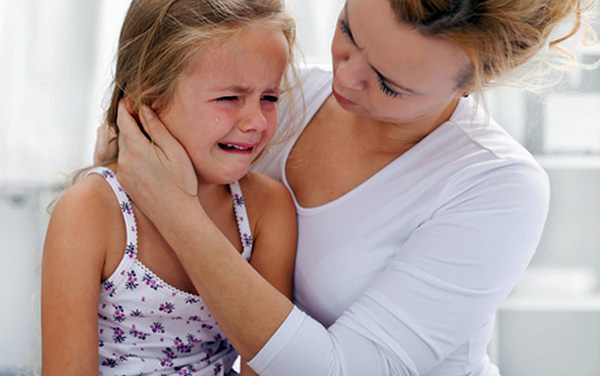
So, with toothache:
- Do not lie on the side of a diseased tooth;
- Do not lie on a swollen cheek;
- Do not warm the sore spot outside (warm rinses are acceptable, but applying a heating pad to the cheek from the side of a diseased tooth is strongly discouraged);
- Do not give your child too hot or cold, sweet and hard foods. It is better to feed the child with soft food at room temperature;
- It is forbidden to give small children Analgin, Citramon, Ketanov and other drugs that are contraindicated before 12 years of age;
- You can not give the child an anesthetic for a long time, hoping that the tooth will fall out soon;
- You cannot postpone a visit to the dentist if the child’s acute toothache has decreased or even gone away. Caries itself does not go away, and inflammatory diseases can go into a chronic form.
What awaits the baby at the dentist's appointment
It is known that when visiting doctors, children often behave far from what their parents would like: a child can cry, scream, break out, bite ...
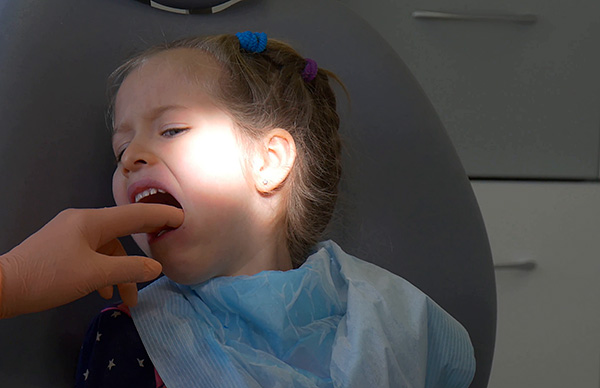
Some techniques can reduce the level of stress in the baby and prevent the formation of psychological trauma.
Before visiting the clinic, the baby needs to be told that the doctor will examine the teeth, clean them and treat them, but it’s better to omit all the details. It’s not worth saying that it won’t hurt, because even a shot of anesthesia may seem painful to the child, and then he will feel cheated.
It is necessary to lead the child precisely to the pediatric dentist who knows how to find an approach and calm the baby (although even this does not always work). There can be many toys in his office, and on the wall in front of the armchair there is a screen with cartoons. To dispel the anxiety of the child, usually the reception does not begin immediately with treatment. The kid has the opportunity to look around and meet a doctor.
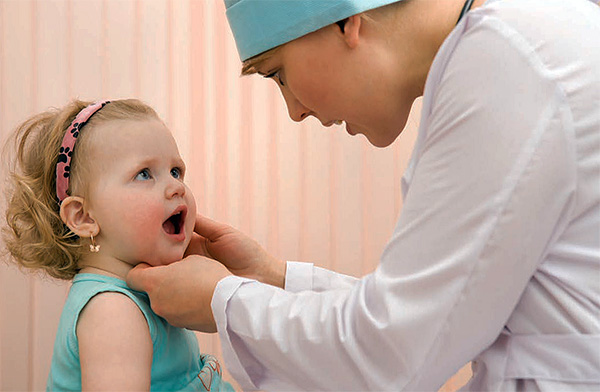
It's important to know
If the child begins to be capricious and it is not possible to calm him down, then it is not necessary to forcefully carry out the treatment so that there is no psychological trauma and steady fear is formed. Better to leave, and then make an appointment for a second appointment.
In some children's dental clinics, psychologists work who can help the child mentally prepare for dental treatment.
In difficult cases, when the child is very restless or a long and difficult treatment is ahead, he can be carried out under general anesthesia or sedation.
Sedation is carried out, for example, using a mixture of oxygen and nitrous oxide, which is inhaled through a mask. With mild sedation, the child remains conscious, but relaxes and calms down, and with deep sedation, it sinks into sleep. Sedation is used for children from three years.
If sedation is not suitable, the child may undergo general anesthesia if indicated. Modern drugs have much less contraindications and side effects than those that were used before. The use of anesthesia or sedation does not affect the physical or psychological health of the baby. He regains consciousness immediately after the procedure.
For local anesthesia, anesthetics are used. Moreover, before the injection, the doctor can anesthetize the child's gums with a spray or novocaine gel to exclude any pain, even from the introduction of a needle.
On a note
Silver teeth are sometimes used on milk teeth. Silvering does not cure tooth decay, but this preventive procedure in the initial stages helps to some extent prevent the spread of the carious process on the enamel surface or between adjacent teeth. The tooth is treated with a silver nitrate based product, as a result of which it acquires a gray or black color. The procedure is repeated 3-5 times.
Silvering is painless and easily tolerated by children, however, with an insufficient level of oral hygiene, this procedure will have practically no effect - the teeth will continue to decay actively.
Prevention of caries in children
You need to take care of the health of the child’s teeth immediately after teething. Without proper care, “bottle” caries develops very quickly in infants, which actively progresses and often spreads across all teeth. To prevent this, you need to wipe the teeth with a special fingertip (sold in a pharmacy).
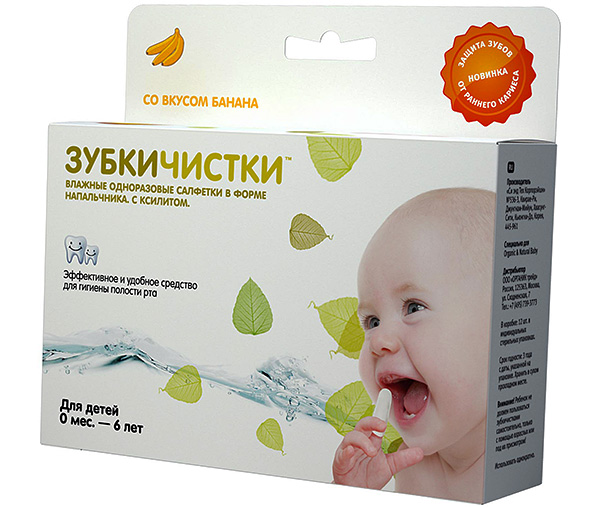
It is very important to teach a child to brush his teeth from an early age. Today there are many children's toothbrushes and pastes with different tastes, and the whole procedure can be easily turned into a fun game.The baby should brush his teeth twice a day, and rinse his mouth with clean water - after each meal.
According to many parents, it’s been possible to teach a child to brush their teeth independently and enter this habit from 2-4 years old.
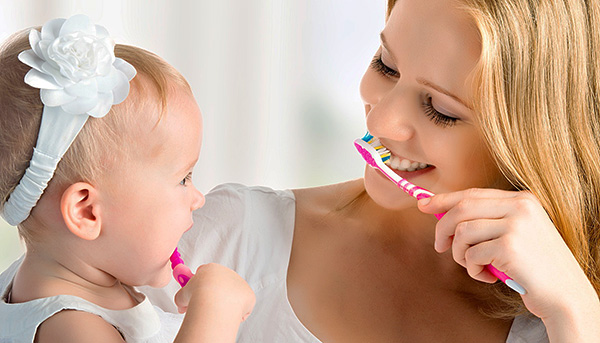
To clean the gaps between the teeth you need dental floss or irrigator. There are special children's threads that the baby will easily use on their own.
Do not forget also that for the health of the teeth is important not only their hygiene, but also proper nutrition. With a lack of vitamins and minerals, tooth enamel may become thinner, which leads to the appearance and development of caries.
As a preventive measure, you need to visit a dentist with a child every 6 months. In the initial stages of caries, it is possible to notice its foci on enamel only during a professional examination. Therefore, the sooner the child visits the dentist, the lower the risk of developing severe pathologies.
Be healthy!
How to prepare your child for a dentist
Useful video: why it is so important to treat milk teeth on time

